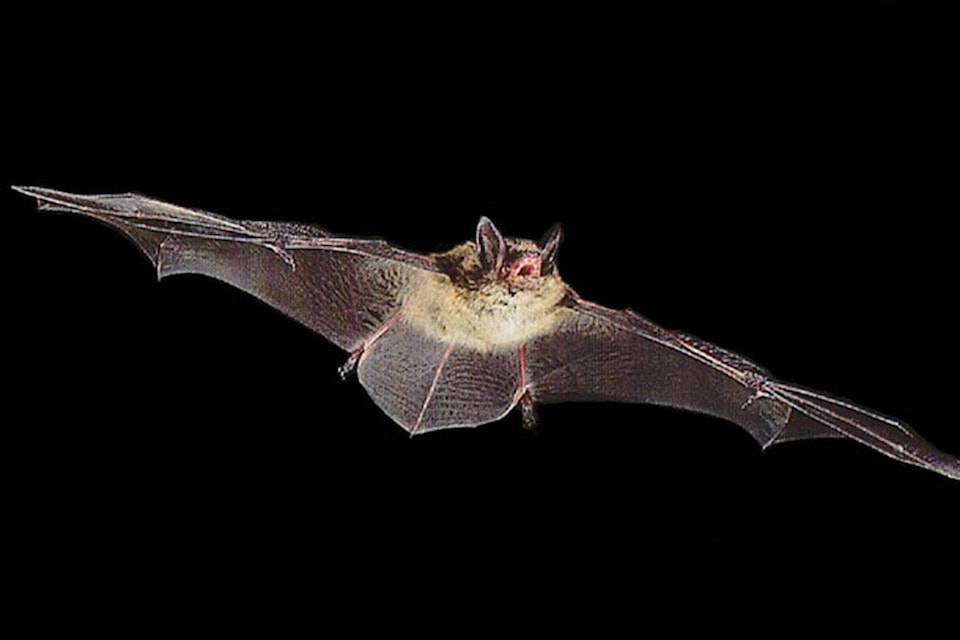~This is the third part in a four-part series on bats in Alberta
Despite their importance to the ecosystem, researchers say it is difficult to get a grasp on just how many bats there are in the wild.
According to Robert Barclay, a professor in the University of Calgary biosciences department, one of the challenges in counting bats is their size.
“The biggest is the hoary bat,” said Barclay.
“It’s the one we know the most about.”
The hoary bat is one of three migratory bats in Alberta and one of nine different species in the province.
“They are normally long-lived animals,” said Barclay, noting that some have lived 30-40 years.
Hoary bats weigh in at around 35 grams, making them the largest bats in Canada. Another migratory bat is the silver-haired bat, which is also a larger creature. The final migratory bat found in the province is the eastern red bat, about which little is known.
Non-migratory bats in the province include the big brown bat, which ways in around 20 grams, and the myotis family of bats, of which there are five different varieties ranging in size from five to 10 grams.
“It’s hard to estimate the overall population size,” said Barclay.
“They are hard to find.”
Barclay notes that due to bats’ small size, radio tracking doesn’t work effectively as the batteries in the transmitters are too small to last very long.
“Batteries last two or three weeks,” said Barclay.
“They’re too small to put those sorts of trackers on them.”
Another problem is finding them; according to the information on the Alberta Community Bat Program website, there is very little known about some species, like red bats, because researchers just can’t locate them in the wild.
“Almost nothing is known about reproduction by Eastern Red Bats in western Canada, and most observations are of males and non-reproductive females, making it uncertain whether they actually breed in the province,” notes reference material on the website.
Barclay noted that two challenges facing bat populations in North America are wind farms and “white-nose syndrome.”
“There are higher (wind farm) fatalities closer to the mountains,” said Barclay.
“In the middle of the prairies, fewer are killed due to fewer bats flying.”
According to Barclay, wind facilities have a greater impact on migratory bats than on non-migratory bats, and the placement of wind towers away from known migratory routes can ease the impact on bat populations.
Another way to ease the impact on bat populations is curtailment, where turbines are locked off in the evening hours during low wind speeds at peak migration times during August and September.
Barclay says that early studies on curtailment have shown that it can reduce bat fatalities by 50-60 per cent.
White-nose syndrome, the other issue, poses different challenges, according to Barclay.
The syndrome is caused by a fungus primarily in the hibernating bat populations. The fungus was first found in Europe, but it eventually made its way over to the East Coast of North America and has slowly been making its way west.
White-nose syndrome causes bats to “wake up” more often than normal during hibernation resulting in the creatures using more of their stored energy.
“Basically, they starve to death,” said Barclay.
However, it’s not all bad news; Barclay says that thanks to natural selection, bats have been hibernating more “spread out” rather than clusters, which has been reducing the transmission of the fungus and allowing the populations in the East to recover.
“We still don’t know how it’s going to affect Alberta,” said Barclay, noting that the fungus was detected in the province in 2023.
Complicating recovery for the creatures is the reproduction of bats; While people may think of bats as “flying mice,” that is not true. In fact, depending on the species, bats can have usually one, but up to a maximum of four, offspring every year.
“It’s harder for the populations to recover,” said Barclay.
“They have a slow life history.”
Bats help the ecosystem by controlling the population of insects.
-With files from the Alberta Community Bat Program
